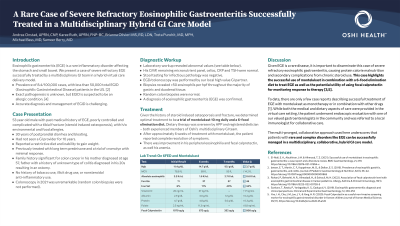Tuesday Poster Session
Category: Stomach
P5068 - A Rare Case of Severe Refractory Eosinophilic Gastroenteritis Successfully Treated in a Multidisciplinary Hybrid GI Care Model
Tuesday, October 29, 2024
10:30 AM - 4:00 PM ET
Location: Exhibit Hall E

Has Audio

Andrea Onstad, NP (she/her/hers)
Oshi Health
New York, NY
Presenting Author(s)
Andrea Onstad, NP1, Karee Ruth, MSN, APN, FNP2, Brianna Olivieri, RD3, Treta Purohit, MD4, Michael Bass, MD5, Sameer Berry, MD, MBA6
1Oshi Health, New York, NY; 2Oshi Health, Powell, TN; 3Integrated Digestive Partners, PLLC, Chadds Ford, PA; 4Oshi Health, Saratoga, CA; 5Oshi Health, Philadelphia, PA; 6NYU Langone Health, New York, NY
Introduction: Eosinophilic gastroenteritis (EGE) is a rare inflammatory disorder affecting the stomach and small bowel. We present a case of severe refractory EGE successfully treated by an advanced practice provider (APP) led team in a multidisciplinary hybrid gastrointestinal (GI) care model.
Case Description/Methods: A 53 year old male with a history of EGE, tibial fracture due to steroid induced osteoporosis, environmental and food allergies presented to our multidisciplinary virtual GI practice in July 2023 for postprandial diarrhea and bloating since the 1990s. He reported a restrictive diet and inability to gain weight. His EGE was previously treated with long term prednisone and a trial of cromolyn, with minimal response. Labs revealed microcytic iron deficiency anemia with a hemoglobin 11.4 g/dL, MCV 78.8 fL, absolute eosinophils 3.0 K/uL, hypoalbuminemia 2.9 g/dL, hypoproteinemia 4.7 g/dL, folate and vitamin D deficiencies, and elevated fecal calprotectin 1070 ug/g. The patient was referred to a local gastroenterologist for an upper endoscopy and colonoscopy. Biopsies revealed > 50 eosinophils per hpf throughout the majority of gastric and duodenal tissue. Eosinophilic gastroenteritis was confirmed given histologic evidence of ample eosinophilic infiltration, presence of peripheral eosinophilia, and exclusion of other etiologies. Given the history of steroid induced osteoporosis with fracture, we determined optimal treatment to be a trial of montelukast 10 mg daily and a 6 food elimination diet (6-FED) initiated by our registered dietitian (RD). Cromolyn was not used due to high cost and previous nonresponse. Six weeks into treatment the patient reported complete resolution of symptoms and there was improvement in both his peripheral eosinophilia (3.0 K/uL to 1.6 K/uL) and his fecal calprotectin (1070 ug/g to 672 ug/g). His nutritional deficiencies resolved as well.
Discussion: Given EGE is a rare disease, it is important to disseminate this case of severe refractory eosinophilic gastroenteritis, causing protein calorie malnutrition and secondary complications from chronic steroid use. This case also highlights that patients with rare and complex disorders like EGE can be successfully managed in a multidisciplinary, collaborative, hybrid GI care model. While both the medical and dietary aspects of care were provided in the virtual care setting, the patient underwent endoscopic evaluation at a brick and mortar facility and was referred to a local immunologist for collaborative care as well.
Disclosures:
Andrea Onstad, NP1, Karee Ruth, MSN, APN, FNP2, Brianna Olivieri, RD3, Treta Purohit, MD4, Michael Bass, MD5, Sameer Berry, MD, MBA6. P5068 - A Rare Case of Severe Refractory Eosinophilic Gastroenteritis Successfully Treated in a Multidisciplinary Hybrid GI Care Model, ACG 2024 Annual Scientific Meeting Abstracts. Philadelphia, PA: American College of Gastroenterology.
1Oshi Health, New York, NY; 2Oshi Health, Powell, TN; 3Integrated Digestive Partners, PLLC, Chadds Ford, PA; 4Oshi Health, Saratoga, CA; 5Oshi Health, Philadelphia, PA; 6NYU Langone Health, New York, NY
Introduction: Eosinophilic gastroenteritis (EGE) is a rare inflammatory disorder affecting the stomach and small bowel. We present a case of severe refractory EGE successfully treated by an advanced practice provider (APP) led team in a multidisciplinary hybrid gastrointestinal (GI) care model.
Case Description/Methods: A 53 year old male with a history of EGE, tibial fracture due to steroid induced osteoporosis, environmental and food allergies presented to our multidisciplinary virtual GI practice in July 2023 for postprandial diarrhea and bloating since the 1990s. He reported a restrictive diet and inability to gain weight. His EGE was previously treated with long term prednisone and a trial of cromolyn, with minimal response. Labs revealed microcytic iron deficiency anemia with a hemoglobin 11.4 g/dL, MCV 78.8 fL, absolute eosinophils 3.0 K/uL, hypoalbuminemia 2.9 g/dL, hypoproteinemia 4.7 g/dL, folate and vitamin D deficiencies, and elevated fecal calprotectin 1070 ug/g. The patient was referred to a local gastroenterologist for an upper endoscopy and colonoscopy. Biopsies revealed > 50 eosinophils per hpf throughout the majority of gastric and duodenal tissue. Eosinophilic gastroenteritis was confirmed given histologic evidence of ample eosinophilic infiltration, presence of peripheral eosinophilia, and exclusion of other etiologies. Given the history of steroid induced osteoporosis with fracture, we determined optimal treatment to be a trial of montelukast 10 mg daily and a 6 food elimination diet (6-FED) initiated by our registered dietitian (RD). Cromolyn was not used due to high cost and previous nonresponse. Six weeks into treatment the patient reported complete resolution of symptoms and there was improvement in both his peripheral eosinophilia (3.0 K/uL to 1.6 K/uL) and his fecal calprotectin (1070 ug/g to 672 ug/g). His nutritional deficiencies resolved as well.
Discussion: Given EGE is a rare disease, it is important to disseminate this case of severe refractory eosinophilic gastroenteritis, causing protein calorie malnutrition and secondary complications from chronic steroid use. This case also highlights that patients with rare and complex disorders like EGE can be successfully managed in a multidisciplinary, collaborative, hybrid GI care model. While both the medical and dietary aspects of care were provided in the virtual care setting, the patient underwent endoscopic evaluation at a brick and mortar facility and was referred to a local immunologist for collaborative care as well.
Disclosures:
Andrea Onstad indicated no relevant financial relationships.
Karee Ruth indicated no relevant financial relationships.
Brianna Olivieri indicated no relevant financial relationships.
Treta Purohit indicated no relevant financial relationships.
Michael Bass: Oshi Health – Employee.
Sameer Berry indicated no relevant financial relationships.
Andrea Onstad, NP1, Karee Ruth, MSN, APN, FNP2, Brianna Olivieri, RD3, Treta Purohit, MD4, Michael Bass, MD5, Sameer Berry, MD, MBA6. P5068 - A Rare Case of Severe Refractory Eosinophilic Gastroenteritis Successfully Treated in a Multidisciplinary Hybrid GI Care Model, ACG 2024 Annual Scientific Meeting Abstracts. Philadelphia, PA: American College of Gastroenterology.
